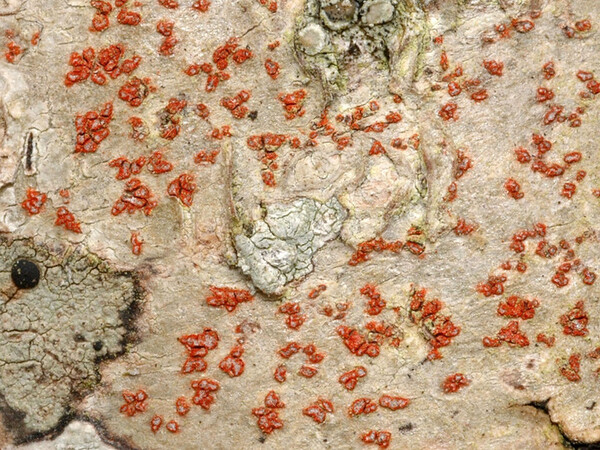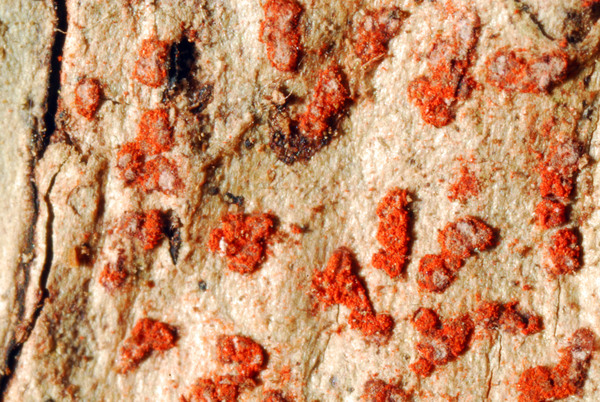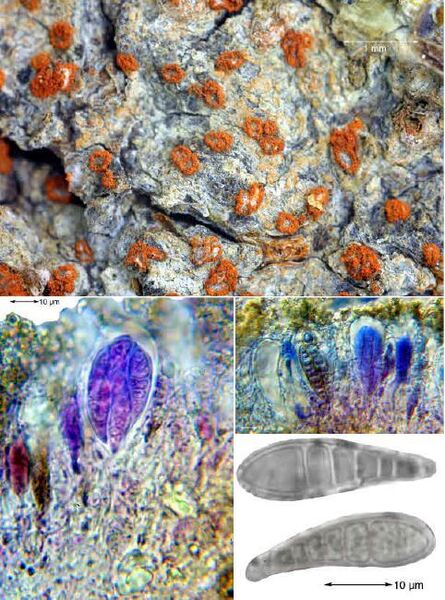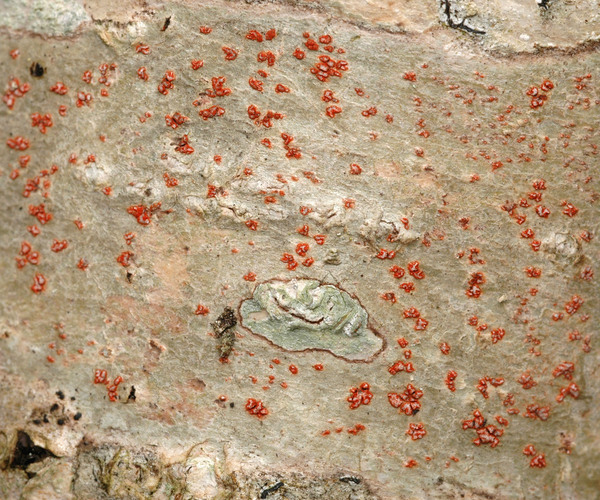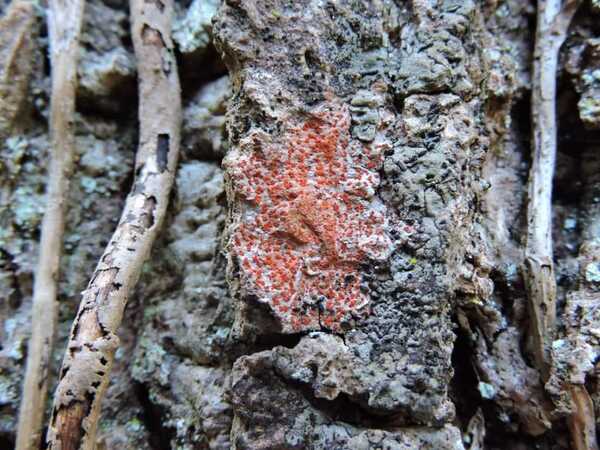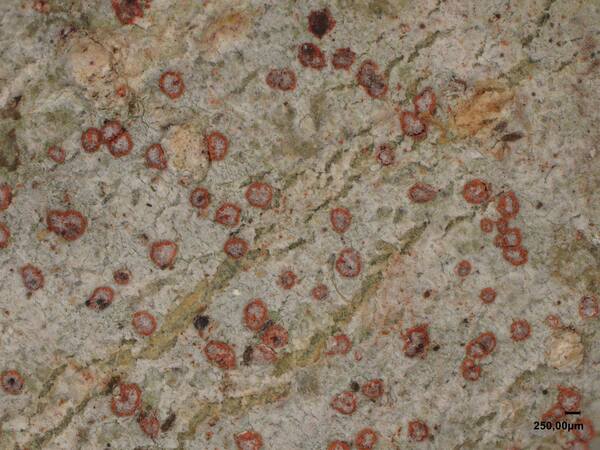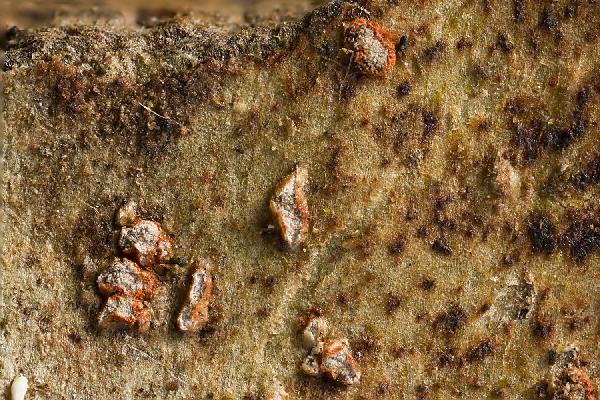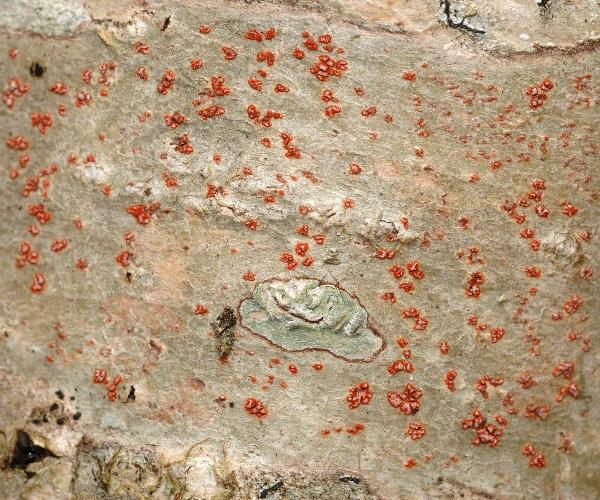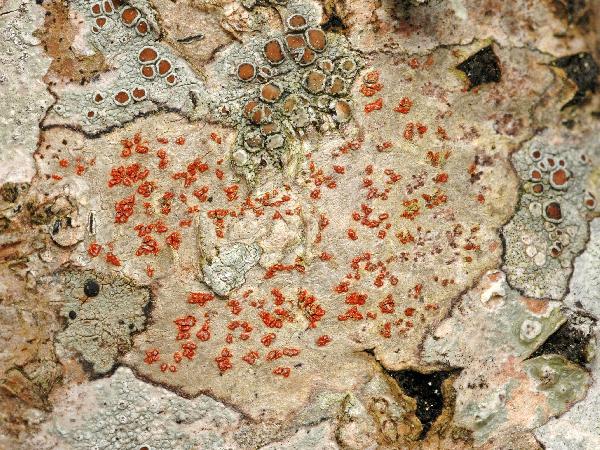Coniocarpon cinnabarinum DC.
in Lamarck & de Candolle, Fl. Franç., 3, 2 éd.: 323, 1805.
Synonyms: Arthonia affinis (A. Massal.) Jatta; Arthonia cinnabarina (DC.) Wallr.; Arthonia gregaria (Weigel) Körb. non Fée; Arthonia gregaria f. coccinea (Flörke) Jatta; Arthonia tumidula (Ach.) Ach.; Coniocarpon affine A. Massal.; Coniocarpon gregarium (Weigel) Schaer.; Coniocarpon gregarium var. glabrum A. Massal.; Coniocarpon gregarium var. opegraphoides A. Massal.; Lepra kermesina auct. ital.; Lepra rubens auct. ital.; Spiloma tumidulum Ach.
Distribution: N - Frl, Ven (Lazzarin 2000b, Nascimbene & Marini 2010), TAA (Nascimbene & al. 2007b), Lomb (Valcuvia & Truzzi 2007, 2007b), Piem (Matteucci & al. 2008b), Emil (Fariselli & al. 2020), Lig. C - Tosc (Putortì & Loppi 1999, Pasquinelli & al. 2009, Pasquinelli & Puccini 2010), Marc, Umb (Genovesi & al. 2001, Ravera & al. 2006), Laz (Ravera & al. 2003, Ravera 2006c, Munzi & al. 2007), Abr (Caporale 2015), Sar. S - Camp (Puntillo & al. 2000, Ricciardi & al. 2000, Aprile & al. 2003b, Nimis & Tretiach 2004), Pugl (Nimis & Tretiach 1999), Bas (Nimis & Tretiach 1999), Cal (Puntillo 1995, 1996, Sérusiaux 1998, Puntillo & Puntillo 2012), Si (Nimis & al. 1994, Grillo & Cristaudo 1995, Ravera & al. 2024).
Description: Thallus crustose, endosubstratic or thinly episubstratic, up to 70 µm thick, white to pale grey, sometimes with a pale orange tinge, often bordered by red-brown prothalline lines. Apothecia arthonioid, soon erumpent and sessile, round to narrowly ellipsoid or polygonal, rarely lobed, 0.2-0.7(-1.3) mm, with a reddish brown, flat to convex disc often densely covered by a white or red pruina, the marginal parts almost always bright red-pruinose, especially in young apothecia. Proper exciple poorly developed, of branched and anastomosing, vertically oriented, paraphysoid-like hyphae often incrusted by orange, red or purple granules, amyloid; epithecium more or less inspersed with orange, red or purple and/or colourless crystals soluble in K, 10-20 µm high, K+ red; hymenium colourless to pale yellow, 60-70(-100) µm high, K-, hemiamyloid, I+ red, K/I+ blue; paraphysoids branched and anastomosing above the asci, slightly sinuous, 1-1.5 µm thick, but often brown-walled and to 2.5 µm thick in epithecium; hypothecium colourless to yellowish or pale reddish brown, 25-40(-50) µm high, hemiamyloid, I+ red, K/I+ blue. Asci 8-spored, broadly clavate to subglobose, semi-fissitunicate, with a large apical dome and a distinct ocular chamber, with a hemiamyloid ring in the tholus, approaching the Arthonia-type. Ascospores (2-)4-5(-7)-septate, at first hyaline, then brownish, oblong ovoid, much larger at one end with progressively smaller cells, (18-)20-28(-33) x (8-)10-11(-12) µm. Pycnidia rare, immersed, the wall red-brown, K+ olive-grey. Conidia hyaline, simple, bacilliform, 3.5-6 x 0.8-1.2(-1.5) µm. Photobiont trentepohlioid. Spot tests: red pigments K+ red-violet, dissolving. Chemistry: different unidentified quinoid pigments in the apothecia.Note: a mild-temperate, perhaps holarctic species mainly found on Fraxinus, but also on trees with harder, more acid bark, such as Carpinus, Fagus and even Quercus ilex, in open, humid broad-leaved woodlands, e.g. along rivers; more frequent in the past, especially in Northern Italy.
Growth form: Crustose
Substrata: bark
Photobiont: Trentepohlia
Reproductive strategy: mainly sexual
Most common in areas with a humid-warm climate (e.g. most of Tyrrenian Italy)
Commonnes-rarity: (info)
Alpine belt: absent
Subalpine belt: absent
Oromediterranean belt: absent
Montane belt: extremely rare
Submediterranean belt: extremely rare
Padanian area: absent
Humid submediterranean belt: very rare
Humid mediterranean belt: rare
Dry mediterranean belt: absent
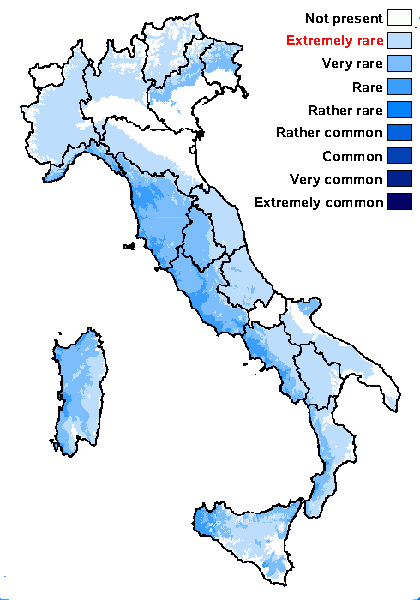
Predictive model
Herbarium samples
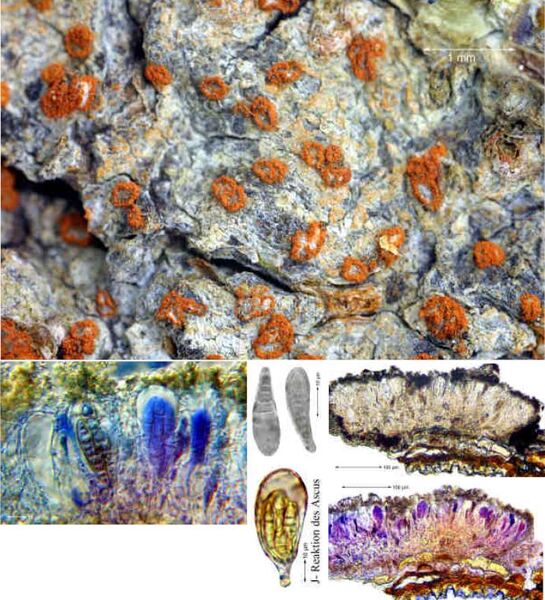

Felix Schumm – CC BY-SA 4.0
Image from: F. Schumm (2008) - Flechten Madeiras, der Kanaren und Azoren. Beck, OHG - ISBN: 978-3-00-023700-3
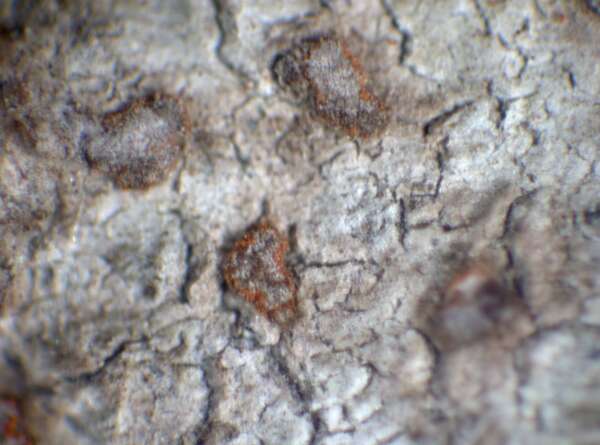

P.L. Nimis; Owner: Department of Life Sciences, University of Trieste
Herbarium: TSB (9497)
2001/11/21
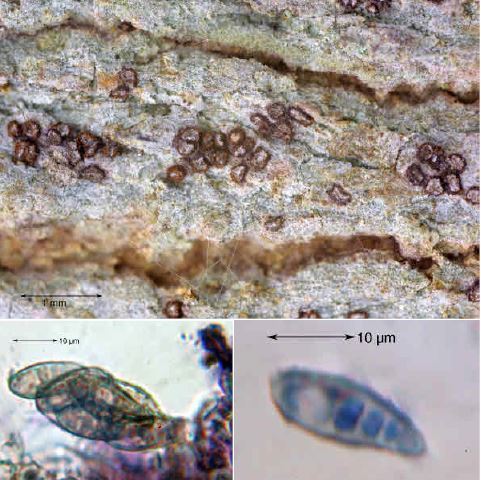

Felix Schumm – CC BY-SA 4.0
[13185], Vietnam, Süd-Vietnam, Region-Saigon, Mekong-Delta bei Vinh Long, auf der Insel Bink Hoa Phuoc. Leg. F. Schumm 01.05.2007, det. F. Schumm, test. M. Grube 08.05.2007
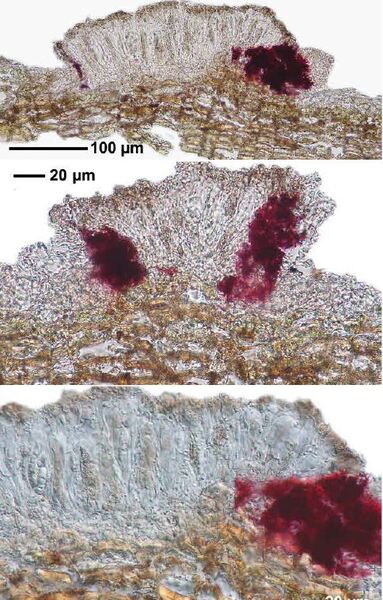

Felix Schumm – CC BY-SA 4.0
[9571], Thailand, Elefantenarbeitslager bei Chiang Mai. 19°14.859' N, 98°58.137' E, 330 m. Leg. Schumm 01.04.2002, det. Aptroot 2009
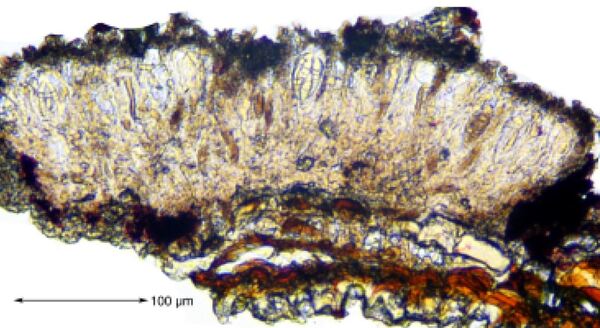

Felix Schumm - CC BY-SA 4.0
Image from: F. Schumm (2008) - Flechten Madeiras, der Kanaren und Azoren. Beck, OHG - ISBN: 978-3-00-023700-3
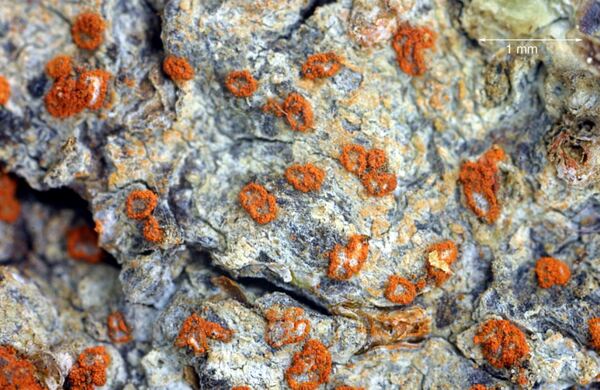

Felix Schumm - CC BY-SA 4.0
Image from: F. Schumm (2008) - Flechten Madeiras, der Kanaren und Azoren. Beck, OHG - ISBN: 978-3-00-023700-3
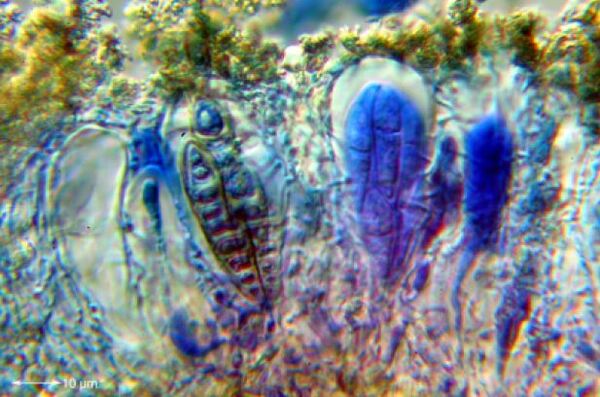

Felix Schumm - CC BY-SA 4.0
Image from: F. Schumm (2008) - Flechten Madeiras, der Kanaren und Azoren. Beck, OHG - ISBN: 978-3-00-023700-3
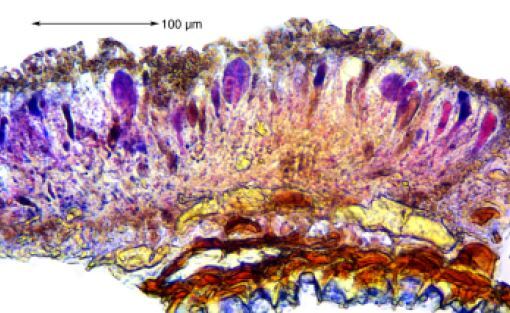

Felix Schumm - CC BY-SA 4.0
Image from: F. Schumm (2008) - Flechten Madeiras, der Kanaren und Azoren. Beck, OHG - ISBN: 978-3-00-023700-3
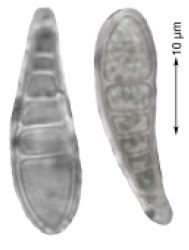

Felix Schumm - CC BY-SA 4.0
Image from: F. Schumm (2008) - Flechten Madeiras, der Kanaren und Azoren. Beck, OHG - ISBN: 978-3-00-023700-3
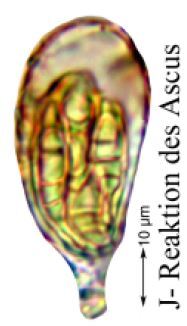

Felix Schumm - CC BY-SA 4.0
Image from: F. Schumm (2008) - Flechten Madeiras, der Kanaren und Azoren. Beck, OHG - ISBN: 978-3-00-023700-3
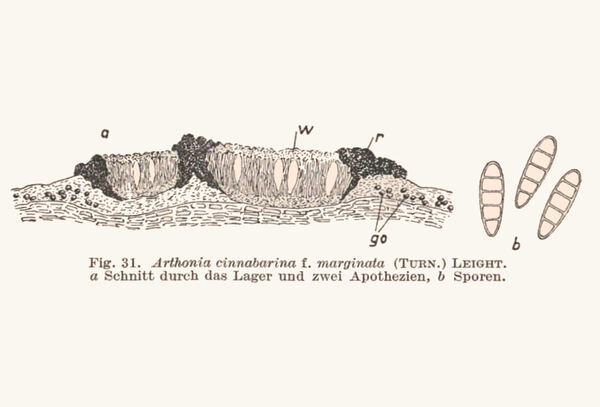
Redinger, K. (1938) Arthoniaceae, Graphidaceae . In Kryptogamen-Flora von Deutschland, Österreich und der Schweiz. Band 9, 2 Abt., Part 1 (G. L. Rabenhorst, ed.): 181–404. Leipzig: Borntraeger
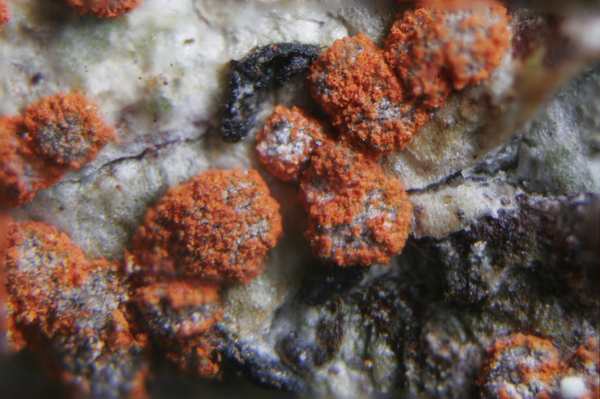
Marta González García - Centro de Estudios Micológicos Asturianos
Spain, Asturias, Teverga, on Castanea

Marta González García - Centro de Estudios Micológicos Asturianos
Spain, Asturias, Teverga, on Castanea
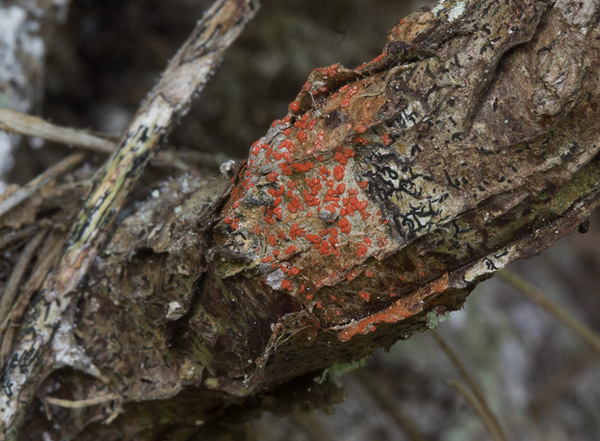
Marta González García - Centro de Estudios Micológicos Asturianos
Spain, Asturias, Teverga, on Castanea
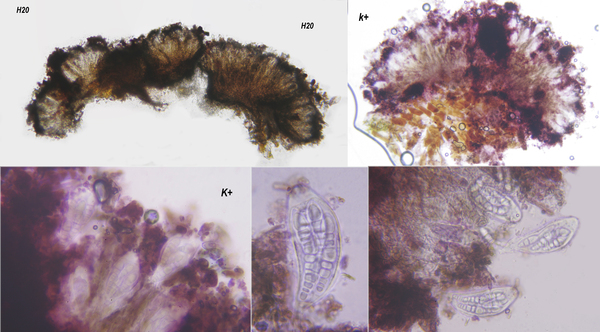
Marta González García - Centro de Estudios Micológicos Asturianos
Spain, Asturias, Teverga, on Castanea

Marta González García - Centro de Estudios Micológicos Asturianos
Spain, Asturias, Teverga, on Castanea
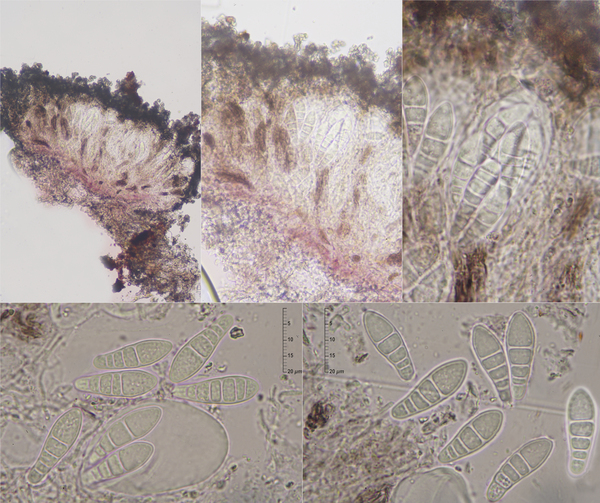
Enrique Rubio y Marta González Centro de Estudios Micológicos Asturianos
Spain, Asturias, Teverga, On Castanea
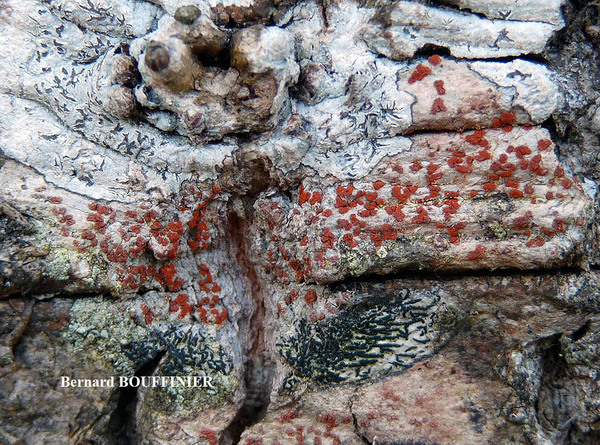
Bernard Bouffinier - Source: http://www.lichensmaritimes.org/index.php?task=fiche&lichen=395&lang=en
France, Camaret
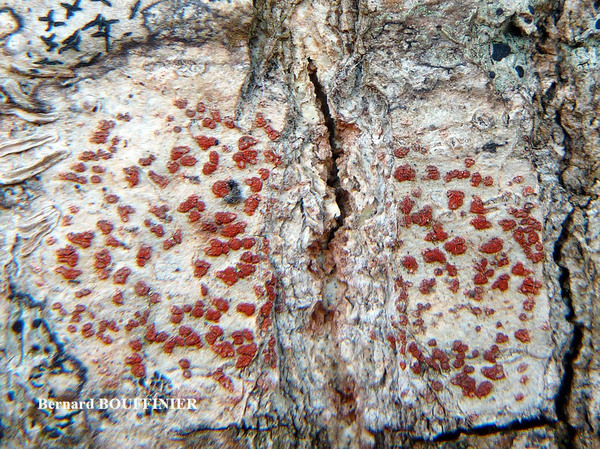
Bernard Bouffinier - Source: http://www.lichensmaritimes.org/index.php?task=fiche&lichen=395&lang=en
France, Camaret
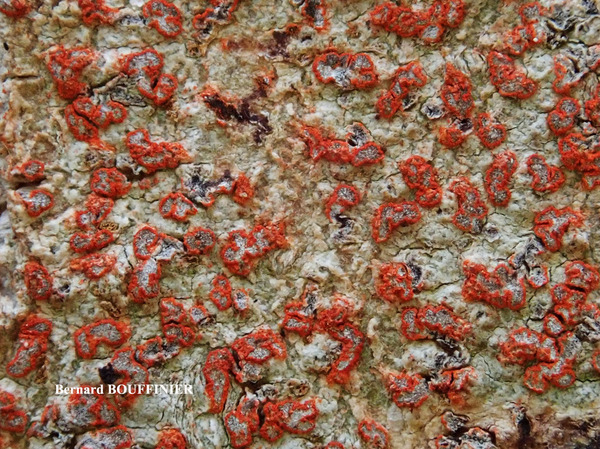
Bernard Bouffinier - Source: http://www.lichensmaritimes.org/index.php?task=fiche&lichen=395&lang=en
France, Crozon
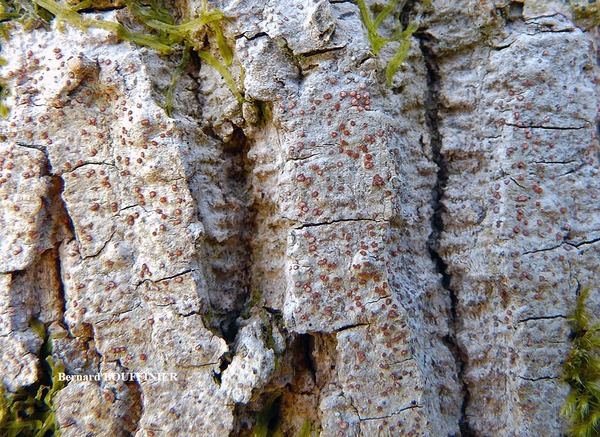
Bernard Bouffinier - Source: http://www.lichensmaritimes.org/index.php?task=fiche&lichen=395&lang=en
France, Crozon
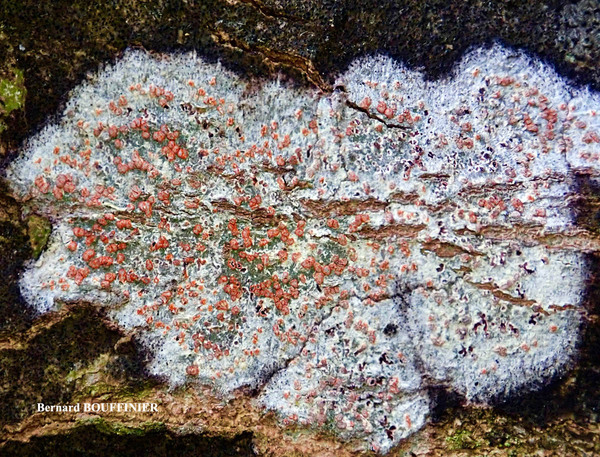
Bernard Bouffinier - Source: http://www.lichensmaritimes.org/index.php?task=fiche&lichen=395&lang=en
France, Crozon
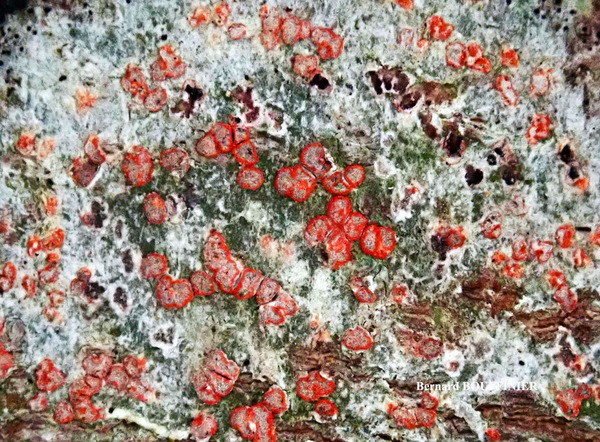
Bernard Bouffinier - Source: http://www.lichensmaritimes.org/index.php?task=fiche&lichen=395&lang=en
France, Crozon

Bernard Bouffinier - Source: http://www.lichensmaritimes.org/index.php?task=fiche&lichen=395&lang=en
France, Crozon
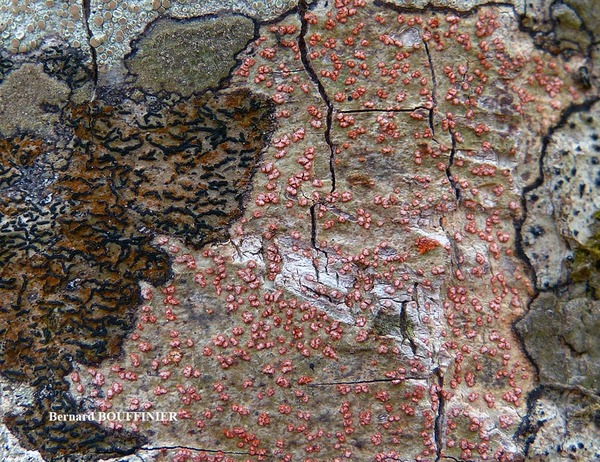
Bernard Bouffinier - Source: http://www.lichensmaritimes.org/index.php?task=fiche&lichen=395&lang=en
France, Crozon
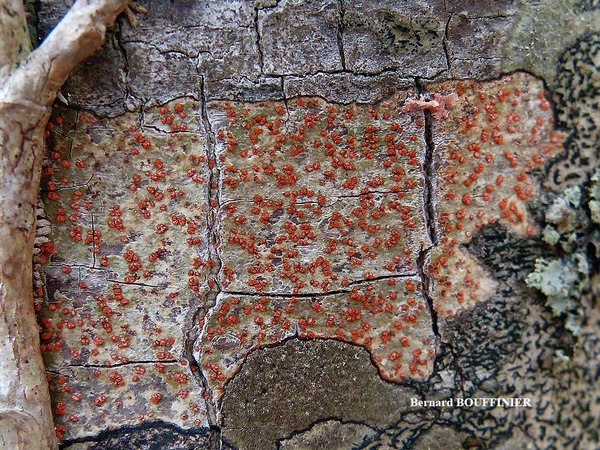
Bernard Bouffinier - Source: http://www.lichensmaritimes.org/index.php?task=fiche&lichen=395&lang=en
France, Kerdreux
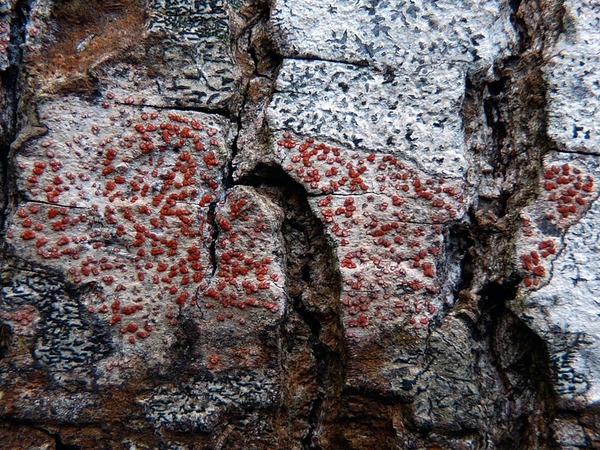
Bernard Bouffinier - Source: http://www.lichensmaritimes.org/index.php?task=fiche&lichen=395&lang=en
France, Le Passage
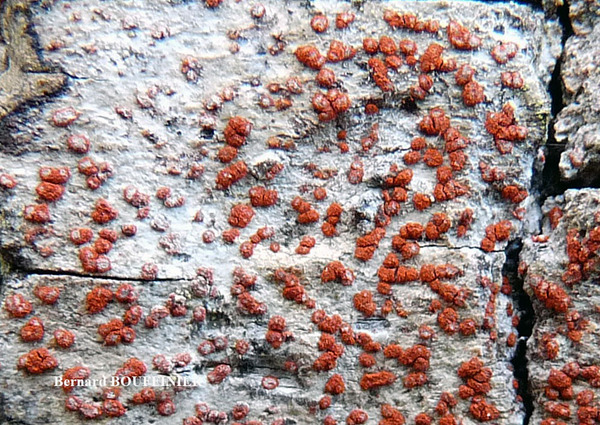
Bernard Bouffinier - Source: http://www.lichensmaritimes.org/index.php?task=fiche&lichen=395&lang=en
France, Le Passage
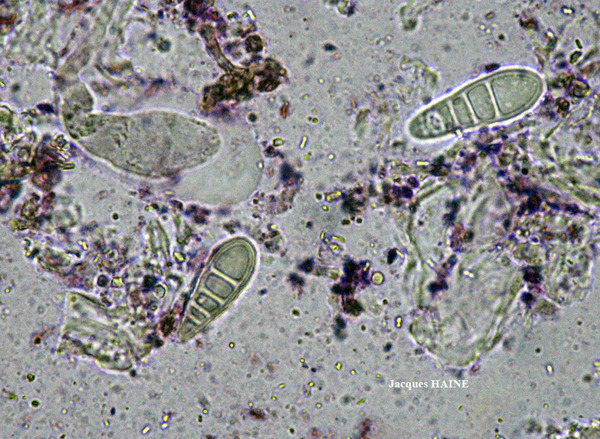
Jacques Haine - Source: http://www.lichensmaritimes.org/index.php?task=fiche&lichen=395&lang=en
France, Crozon
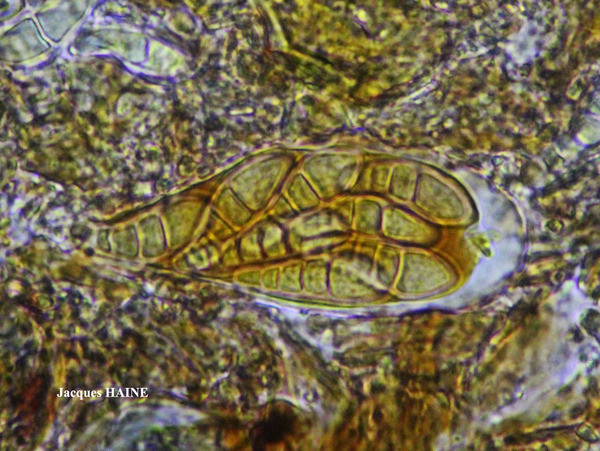
Jacques Haine - Source: http://www.lichensmaritimes.org/index.php?task=fiche&lichen=395&lang=en
France, Kerguzul
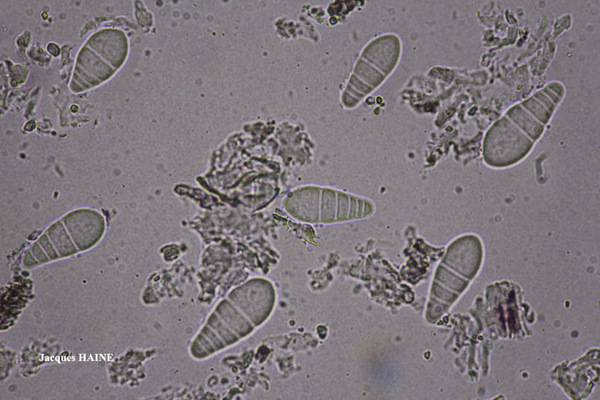
Jacques Haine - Source: http://www.lichensmaritimes.org/index.php?task=fiche&lichen=395&lang=en
France, Kerguzul
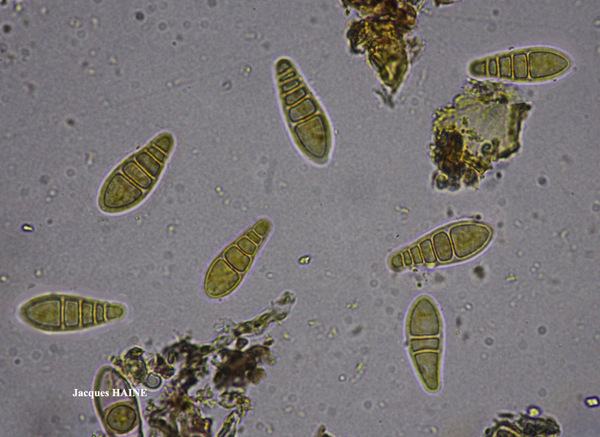
Jacques Haine - Source: http://www.lichensmaritimes.org/index.php?task=fiche&lichen=395&lang=en
France, Kerguzul
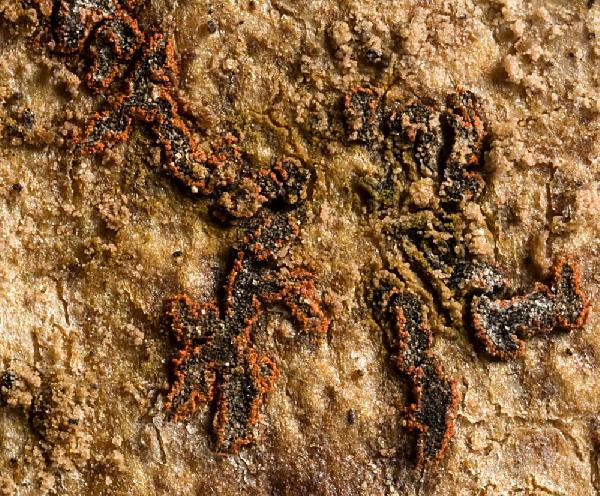
Ulrich Kirschbaum CC BY-SA 4.0 - Source: https://www.thm.de/lse/ulrich-kirschbaum/flechtenbilder
On smooth bark of deciduous trees.Central Europe; Germany: Hesse.(Coll/ident: Eichler/Cezanne).
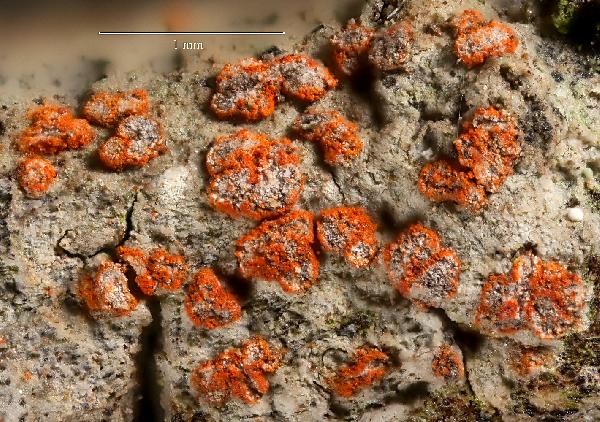
Ulrich Kirschbaum CC BY-SA 4.0 - Source: https://www.thm.de/lse/ulrich-kirschbaum/flechtenbilder
On twigs of Cupressus sempervirens.
SE Europe; N-Cyprus; E of Girne; Beşparmak Mountains; between Kantara Village and Kantara Castle (close to Castle)
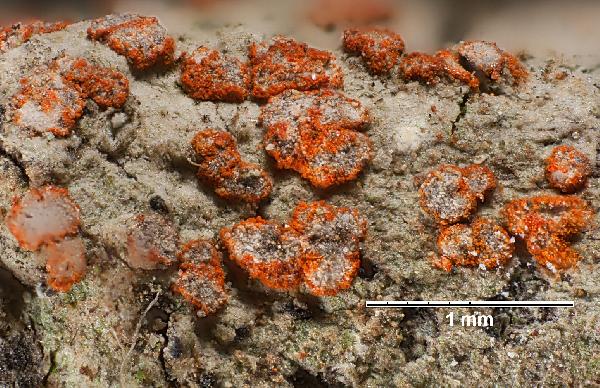
Ulrich Kirschbaum CC BY-SA 4.0 - Source: https://www.thm.de/lse/ulrich-kirschbaum/flechtenbilder
On twigs of Cupressus sempervirens.
SE Europe; N-Cyprus; E of Girne; Beşparmak Mountains; between Kantara Village and Kantara Castle (close to Castle)
Growth form: Crustose
Substrata: bark
Photobiont: Trentepohlia
Reproductive strategy: mainly sexual
Most common in areas with a humid-warm climate (e.g. most of Tyrrenian Italy)
Commonnes-rarity: (info)
Alpine belt: absent
Subalpine belt: absent
Oromediterranean belt: absent
Montane belt: extremely rare
Submediterranean belt: extremely rare
Padanian area: absent
Humid submediterranean belt: very rare
Humid mediterranean belt: rare
Dry mediterranean belt: absent

Predictive model
| Herbarium samples |


Felix Schumm – CC BY-SA 4.0
Image from: F. Schumm (2008) - Flechten Madeiras, der Kanaren und Azoren. Beck, OHG - ISBN: 978-3-00-023700-3


P.L. Nimis; Owner: Department of Life Sciences, University of Trieste
Herbarium: TSB (9497)
2001/11/21


Felix Schumm – CC BY-SA 4.0
[13185], Vietnam, Süd-Vietnam, Region-Saigon, Mekong-Delta bei Vinh Long, auf der Insel Bink Hoa Phuoc. Leg. F. Schumm 01.05.2007, det. F. Schumm, test. M. Grube 08.05.2007


Felix Schumm – CC BY-SA 4.0
[9571], Thailand, Elefantenarbeitslager bei Chiang Mai. 19°14.859' N, 98°58.137' E, 330 m. Leg. Schumm 01.04.2002, det. Aptroot 2009


Felix Schumm - CC BY-SA 4.0
Image from: F. Schumm (2008) - Flechten Madeiras, der Kanaren und Azoren. Beck, OHG - ISBN: 978-3-00-023700-3


Felix Schumm - CC BY-SA 4.0
Image from: F. Schumm (2008) - Flechten Madeiras, der Kanaren und Azoren. Beck, OHG - ISBN: 978-3-00-023700-3


Felix Schumm - CC BY-SA 4.0
Image from: F. Schumm (2008) - Flechten Madeiras, der Kanaren und Azoren. Beck, OHG - ISBN: 978-3-00-023700-3


Felix Schumm - CC BY-SA 4.0
Image from: F. Schumm (2008) - Flechten Madeiras, der Kanaren und Azoren. Beck, OHG - ISBN: 978-3-00-023700-3


Felix Schumm - CC BY-SA 4.0
Image from: F. Schumm (2008) - Flechten Madeiras, der Kanaren und Azoren. Beck, OHG - ISBN: 978-3-00-023700-3


Felix Schumm - CC BY-SA 4.0
Image from: F. Schumm (2008) - Flechten Madeiras, der Kanaren und Azoren. Beck, OHG - ISBN: 978-3-00-023700-3

Redinger, K. (1938) Arthoniaceae, Graphidaceae . In Kryptogamen-Flora von Deutschland, Österreich und der Schweiz. Band 9, 2 Abt., Part 1 (G. L. Rabenhorst, ed.): 181–404. Leipzig: Borntraeger

Marta González García - Centro de Estudios Micológicos Asturianos
Spain, Asturias, Teverga, on Castanea

Marta González García - Centro de Estudios Micológicos Asturianos
Spain, Asturias, Teverga, on Castanea

Marta González García - Centro de Estudios Micológicos Asturianos
Spain, Asturias, Teverga, on Castanea

Marta González García - Centro de Estudios Micológicos Asturianos
Spain, Asturias, Teverga, on Castanea

Marta González García - Centro de Estudios Micológicos Asturianos
Spain, Asturias, Teverga, on Castanea

Enrique Rubio y Marta González Centro de Estudios Micológicos Asturianos
Spain, Asturias, Teverga, On Castanea

Bernard Bouffinier - Source: http://www.lichensmaritimes.org/index.php?task=fiche&lichen=395&lang=en
France, Camaret

Bernard Bouffinier - Source: http://www.lichensmaritimes.org/index.php?task=fiche&lichen=395&lang=en
France, Camaret

Bernard Bouffinier - Source: http://www.lichensmaritimes.org/index.php?task=fiche&lichen=395&lang=en
France, Crozon

Bernard Bouffinier - Source: http://www.lichensmaritimes.org/index.php?task=fiche&lichen=395&lang=en
France, Crozon

Bernard Bouffinier - Source: http://www.lichensmaritimes.org/index.php?task=fiche&lichen=395&lang=en
France, Crozon

Bernard Bouffinier - Source: http://www.lichensmaritimes.org/index.php?task=fiche&lichen=395&lang=en
France, Crozon

Bernard Bouffinier - Source: http://www.lichensmaritimes.org/index.php?task=fiche&lichen=395&lang=en
France, Crozon

Bernard Bouffinier - Source: http://www.lichensmaritimes.org/index.php?task=fiche&lichen=395&lang=en
France, Crozon

Bernard Bouffinier - Source: http://www.lichensmaritimes.org/index.php?task=fiche&lichen=395&lang=en
France, Kerdreux

Bernard Bouffinier - Source: http://www.lichensmaritimes.org/index.php?task=fiche&lichen=395&lang=en
France, Le Passage

Bernard Bouffinier - Source: http://www.lichensmaritimes.org/index.php?task=fiche&lichen=395&lang=en
France, Le Passage

Jacques Haine - Source: http://www.lichensmaritimes.org/index.php?task=fiche&lichen=395&lang=en
France, Crozon

Jacques Haine - Source: http://www.lichensmaritimes.org/index.php?task=fiche&lichen=395&lang=en
France, Kerguzul

Jacques Haine - Source: http://www.lichensmaritimes.org/index.php?task=fiche&lichen=395&lang=en
France, Kerguzul

Jacques Haine - Source: http://www.lichensmaritimes.org/index.php?task=fiche&lichen=395&lang=en
France, Kerguzul

Ulrich Kirschbaum CC BY-SA 4.0 - Source: https://www.thm.de/lse/ulrich-kirschbaum/flechtenbilder
On smooth bark of deciduous trees.Central Europe; Germany: Hesse.(Coll/ident: Eichler/Cezanne).

Ulrich Kirschbaum CC BY-SA 4.0 - Source: https://www.thm.de/lse/ulrich-kirschbaum/flechtenbilder
On twigs of Cupressus sempervirens. SE Europe; N-Cyprus; E of Girne; Beşparmak Mountains; between Kantara Village and Kantara Castle (close to Castle)

 Index Fungorum
Index Fungorum
 GBIF
GBIF

